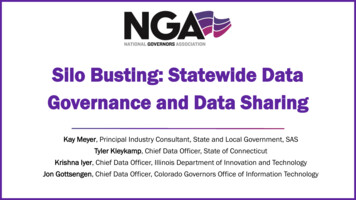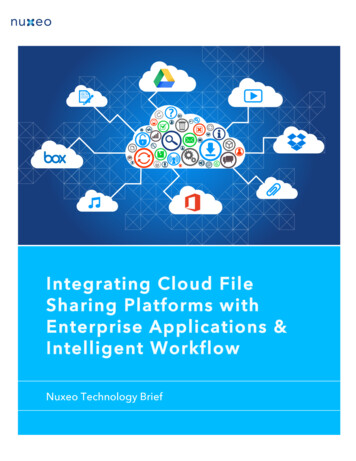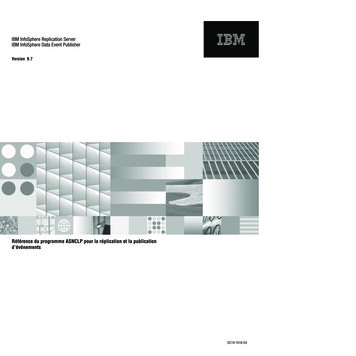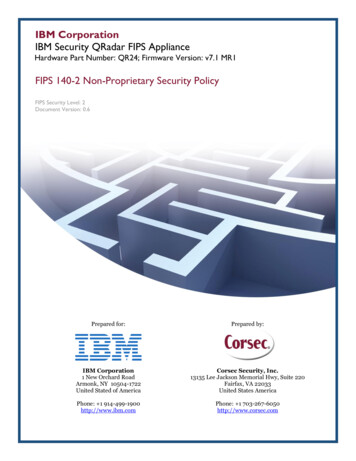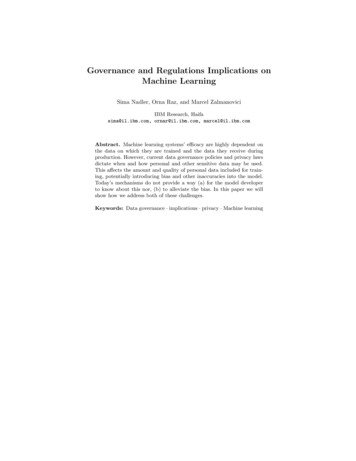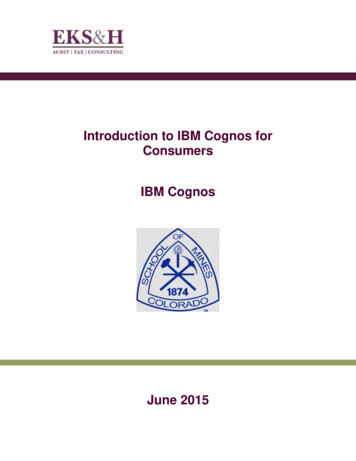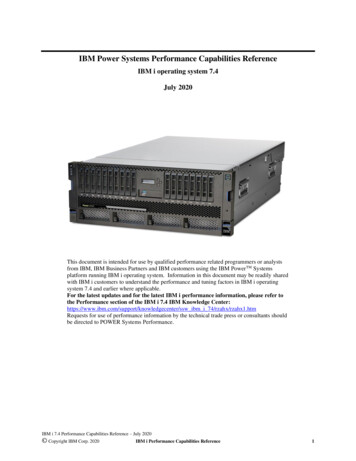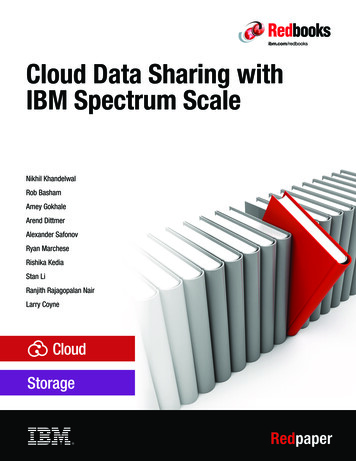
Transcription
Front coverCloud Data Sharing withIBM Spectrum ScaleNikhil KhandelwalRob BashamAmey GokhaleArend DittmerAlexander SafonovRyan MarcheseRishika KediaStan LiRanjith Rajagopalan NairLarry CoyneRedpaper
Cloud data sharing with IBM Spectrum ScaleThis IBM Redpaper publication provides information to help you with the sizing,configuration, and monitoring of hybrid cloud solutions using the Cloud data sharing feature ofIBM Spectrum Scale . IBM Spectrum Scale, formerly IBM General Parallel File System(IBM GPFS ), is a scalable data and file management solution that provides a globalnamespace for large data sets along with several enterprise features. Cloud data sharingallows for the sharing and use of data between various cloud object storage types and IBMSpectrum Scale.Cloud data sharing can help with the movement of data in both directions, between filesystems and cloud object storage, so that data is where it needs to be, when it needs to bethere.This paper is intended for IT architects, IT administrators, storage administrators, and thosewho want to learn more about sizing, configuration, and monitoring of hybrid cloud solutionsusing IBM Spectrum Scale and Cloud data sharing.IntroductionCloud data sharing is a feature available with IBM Spectrum Scale Version 4.2.2 that allowsfor transferring data to and from object storage, using the full lifecycle managementcapabilities of IBM Spectrum Scale information lifecycle management (ILM) policy engine tocontrol the movement of data. This feature is designed to work with many types of objectstorage allowing for the archiving, distribution, or sharing of data between IBM SpectrumScale and object storage.This paper is organized into the following sections: Technology overview: The target audience for this section is anyone who is interested inthis topic. IBM Spectrum Scale Cloud data sharing use cases: This section covers scenarios whereCloud data sharing are typically used, and the target audience is pre-sales and solutionarchitects. Sizing and scaling considerations: This section covers guidance about how to plan for therecommended resources for the sharing service. It also covers suggestions about how todeploy the service. The target audience is solution architects and administrators. Resource requirements and considerations: This sections covers resource planningaspects of using Cloud data sharing. The target audience is solution architects andadministrators. Copyright IBM Corp. 2017. All rights reserved.ibm.com/redbooks1
Configuration and best practices: This section covers recommended settings and tunableparameters when using the Cloud data sharing service. The target audience is solutionarchitects and administrators. Monitoring and lifecycle management: This section covers instruction about monitoring theCloud data sharing service. The target audience is administrators. IBM Spectrum Control: This section covers preferred practices for setting up IBMSpectrum Control to support Cloud data sharing.Technology overviewThis section provides an overview of IBM Spectrum Scale, cloud object storage, and how IBMSpectrum Scale provides a fully integrated, transparent Cloud data sharing service.According to IDC, the total amount of digital information created and replicated surpassed 4.4zettabytes (4,400 exabytes) in 2013. The size of the digital universe is more than doublingevery two years and is expected to grow to almost 44 zettabytes in 2020. Although individualsgenerate most of this data, IDC estimates that enterprises are responsible for 85% of theinformation in the digital universe at some point in its lifecycle. Thus, organizations are takingon the responsibility for designing, delivering, and maintaining IT systems and data storagesystems to meet this demand.1Both IBM Spectrum Scale and object storage, including IBM Cloud Object Storage, aredesigned to deal with this growth. In addition, there’s now a fully integrated transparent Clouddata sharing service that will combine the two. IBM Spectrum Scale can work as a peer withstorage, such as IBM Cloud Object Storage, by facilitating sharing of data in both directionswith cloud object storage.IBM Spectrum Scale overviewIBM Spectrum Scale is a proven, scalable, high-performance data and file managementsolution. It provides world-class storage management with extreme scalability, flashaccelerated performance, and automatic policy-based storage that has tiers of flash throughdisk to tape. IBM Spectrum Scale can help to reduce storage costs up to 90% and to improvesecurity and management efficiency in cloud, big data, and analytics environments.12Source: EMC Digital Universe Study, with data and analysis by IDC, April 2014Cloud Data Sharing with IBM Spectrum Scale
Figure 1 shows a high-level overview of this solution.Users and applicationsClient workstationsCompute FarmSingle namespaceSMB/CIFSPOSIXNFSMap ReduceConnectorOpenStackCinderManilaSwiftGlance Spectrum ScaleSite ASite BAutomated data placement and data migrationSite CTapeFlashDiskStorage RichServersIBM Cloud Object StorageAmazon S3CloudFigure 1 IBM Spectrum Scale overviewTrial VM: IBM Spectrum Scale offers a no-cost try and buy IBM Spectrum Scale Trial VM.The Trial VM offers a fully preconfigured IBM Spectrum Scale instance in a virtualmachine, based on IBM Spectrum Scale GA version. You can download this trial versionfrom IBM developerWorks .Cloud storage overviewObject storage is the primary data resource used in the cloud, and it is also increasingly usedfor on-premise solutions. Object storage is growing for the following reasons: It is designed for scale in many ways (multi-site, multi-tenant, massive amounts of data). It is easy to use and yet meets the growing demands of enterprises for a broad expanse ofapplications and workloads. It allows users to balance storage cost, location, and compliance control requirementsacross data sets and essential applications.Object storage has a simple REST-Based API. Hardware costs are low because it is typicallybuilt on commodity hardware. However, it is key to remember that most object storageservices are only “eventually consistent.” To accommodate the massive scale of data and thewide geographic dispersion, object storage service at times and in places might notimmediately reflect all updates. This lag is typically quite small but can be noticeable whenthere are network failures.Object storage is typically offered as a service on the public cloud, such as Amazon S3 orSoftLayer , but is also available as on premise systems, such as IBM Cloud Object Storage(formerly known as Cleversafe ).For more information about object storage, see the IBM Cloud Storage website.Due to its characteristics, object storage is becoming a significant storage repository foractive archive of unstructured data, both for public and private clouds.3
Object storage: IBM Spectrum Scale also supports object storage as one of its protocols.One of the key differences between IBM Spectrum Scale Object and other object stores,such as IBM Cloud Object Storage, is that the former includes a unified file and objectaccess with Hadoop capabilities and is suitable for high performance oriented or data lakeuse cases. IBM Cloud Object Storage is more of a traditional cloud object store suitable forthe active archive use case.Cloud deployment modelsIBM Cloud Object Storage can be deployed both on and off premise. There are numerousprivate and public cloud offerings.Off premise cloudOff premise public clouds, such as IBM SoftLayer Object Storage or Amazon S3, providestorage options with minimal additional capital equipment and datacenter costs. The ability torapidly provision, expand, and reduce capacity and a pay-as-you-go model make this aflexible option.When considering public clouds, it is important to consider all the costs and the pricingmodels of the cloud solution. Many public clouds charge a monthly fee based on the amountof data stored on the cloud. In addition, many clouds charge a fee for data transferred out ofthe cloud. This charge model makes public clouds ideal for data that is infrequently accessed.Storing data that is accessed frequently in the cloud might result in additional costs. It mightalso be necessary to have a high-speed dedicated network connection to the cloud provider.On premise cloudOn premise cloud solutions, such as IBM Cloud Object Storage, can provide flexible,easy-to-use storage with attractive pricing. On premise clouds allow complete control overdata and high speed network connectivity to the storage solution. This type of solution mightbe ideal for use cases that involve larger files with higher recall rates. For a cloud solution withmultiple access points and IP addresses, an external load balancer is required for highavailability and throughput. Several commercial and open-source load balancers areavailable. Contact your cloud solution provider for supported load balancers.Cloud services major components and terminologyThis section describes the IBM Spectrum Scale cloud services components that are used bythe Cloud data sharing service on IBM Spectrum Scale. A typical multi-node configuration isshown in Figure 2 on page 5 with terminology that will be referenced throughout the paper.4Cloud Data Sharing with IBM Spectrum Scale
Cloud Object StorageCloud AccountContainerContainerNode1Cloud AccountNode 2ContainerNode 4Node3Cloud Service Node GroupCloudServiceNodeNode5ContainerContainerNode 6Node 7Node 9Cloud Service Node odeCloudServiceNodeCloudServiceNodeCES Protocol nodesCloudClientSpectrum ScaleClusterNSD Storage nodesFile SystemNode 8File SystemFile SystemFigure 2 IBM Spectrum Scale cluster with cloud service nodesThe Cloud data sharing service runs on cloud service node groups that consist of cloudservice nodes. For reliability and availability reasons, a group will typically have more thanone node in it. In the current release, one IBM Spectrum Scale file system and one cloudstorage Cloud Account can be configured with one associated container in object storage.Figure 2 shows an example of two node groups with the file systems, the cloud service nodegroups, and the cloud accounts and associated transparent cloud containers colored purpleand red.Cloud servicesThere are two cloud services currently supported: transparent cloud tiering service and Clouddata sharing. For more information about transparent cloud tiering see Enabling Hybrid CloudStorage for IBM Spectrum Scale Using Transparent Cloud Tiering, dp5411.html).Cloud service node groupThe Cloud data sharing service runs on the cloud service node group. Multiple nodes canexist in a group for high availability in failure scenarios and for faster data transfers by sharingthe workload across all nodes in the node group. A node group can be associated only withone IBM Spectrum Scale file system, one Cloud Account, and one data container on thecloud account.5
Cloud service nodeA cloud service node interacts directly with the cloud storage. Transfer requests go to thesenodes and they perform the data transfer. A cloud service node can be defined on an IBMSpectrum Scale protocol node (CES node) or on an IBM Spectrum Scale data node (NSDnode).Cloud accountObject Storage is multi-tenant, but cloud services can talk only to one tenant on the objectstorage, which is represented by the cloud account.Cloud clientThe cloud client can reside on any node in the cluster (provided the OS is supported). Thislightweight client can send cloud service requests to the Cloud data sharing service. Eachcloud service node comes with a built-in cloud client. A cluster can have as many clients asneeded.Cloud data sharing overviewCloud data sharing (see Figure 3 on page 7) allows for movement of data between objectstorage and IBM Spectrum Scale storage: Move data from IBM Spectrum Scale to cloud storage: Export data to cloud storage bysetting up ILM policies that trigger the movement of files from IBM Spectrum Scale tocloud object storage. Move data from cloud storage to IBM Spectrum Scale: Import data from cloud storagefrom a list of objects. (An ILM policy doesn’t work for import because policies can onlyspecify files that are already in the IBM Spectrum Scale file system.)This service provides the following advantages: It is designed for scale in many ways (multi-site, multi-tenant, and massive amounts ofdata). It is easy to use and yet meets the growing demands for sharing or distribution of data fora broad expanse of applications and workloads. It allows users to easily move large amounts of data by policy between object storage andIBM Spectrum Scale. It provides a manifest and an associated manifest utility that can be used to track whatdata has been transferred without needing to use object storage directory services whichcan be problematic as a container scales up.6Cloud Data Sharing with IBM Spectrum Scale
Figure 3 Cloud data sharing overviewCloud data sharing versus transparent cloud tieringCloud data sharing and transparent cloud tiering cloud services both transfer data betweenIBM Spectrum Scale and cloud storage, but they serve different purposes. Here are someideas about how to decide which service to use.You can use Cloud data sharing in the following cases: You need to pull object storage data originating in the cloud into IBM Spectrum Scale. TheCloud data sharing import command performs this service. You need to push data originating in IBM Spectrum Scale out to cloud object storage so itcan be consumed in some way from object storage. The Cloud data sharing exportcommand performs this service. You need to archive IBM Spectrum Scale data out to the cloud and do not want to maintainany information whatsoever on those files in IBM Spectrum Scale. This can be done usingthe export command and then by deleting the associated files that were exported.You can use transparent cloud tiering in the following cases: You want to use cloud storage as a storage tier, migrating data to it as it gets cool andrecalling the data later as needed. You need additional capacity in your file system without purchasing additional hardware. You need to free up space in your primary storage.How Cloud data sharing worksCloud data sharing starts a cloud services daemon on one or more cloud service nodes. Thisdaemon communicates directly to a cloud object storage provider. Any node in an IBMSpectrum Scale cluster can send a request to a cloud service node to import or export data.The requests can be driven either directly via the mmcloudgateway command or through IBMSpectrum Scale ILM policies. Depending on the application, you can schedule the import orexport of data to run periodically or they can be driven by an application or user.7
After a file is exported to the cloud provider, it can be accessed either by another IBMSpectrum Scale cluster or by a cloud-based application. The file data is not modified in anyway, so an application can access the file directly if desired. An optional manifest file can bespecified when exporting a file.The Export, Import, and the Manifest functions are described as follows: ExportExportation of data can be driven by periodic running of a policy on the IBM SpectrumScale ILM policy engine, with the files to be exported selected by conditions that arespecified in the policy. This method is useful for providing consistency between IBMSpectrum Scale files and the object storage over time. ImportImportation of data cannot be done with the policy engine, because the policy engineworks on files that are already in IBM Spectrum Scale. For this reason, the import is drivenby directly requesting a set of files to be created. When importing files, the file data can bemigrated to the IBM Spectrum Scale cluster during the import operation itself, or the filecan be imported as a stub file. If a file is imported as a stub, the file data will not betransferred until the file is accessed on the file system. After the file is present in theoperating system as a stub, a policy to import the data can be run separately with thedecision on what files to pull in fully, depending on the policy engine. The ManifestThe manifest file contains information about the files present in object storage. Thismanifest can be used by another IBM Spectrum Scale cluster to determine what data toimport or it can be used by object storage applications that want to know what data hasbeen exported to object storage. There is a cloud manifest tool that will provide a commaseparated value list of files in a manifest. It can also be used to generate a manifest forcloud storage applications that want to have IBM Spectrum Scale Cloud data sharingservice use the manifest to determine what data to import.IBM Spectrum Scale Cloud data sharing use casesConsider the following key questions which can help determine if a workload is appropriate forcloud sharing: Do you have data that needs to be shared between object storage and your IBM SpectrumScale cluster? Does your data consist of larger size files or objects, such as unstructured objects,images, movies, or documents that you might want to archive to cloud storage that you nolonger need in IBM Spectrum Scale namespace? Do you have requirements for data security, availability of data across multiple sites,scalability, and cost-effectiveness? Do you have the infrastructure or ability to procure the infrastructure required to supportcloud storage, including network connectivity and load balancing services, and private orpublic cloud access?8Cloud Data Sharing with IBM Spectrum Scale
This section showcases the following use cases that can be broadly applied to differentworkloads: Data distribution or sharing between sites Data export/import from native file systems to object storage by sharing data betweenapplications Active ArchiveUse Case: Data distribution or sharing between sitesIn multi-site organizations or at digital media stations that typically involve a setup, such as acentral office with multiple branch offices, data sharing between sites is typically required. Forexample, digital media solutions involve data that needs to be shared across geographicallydistributed sites. Data can originate at the branch office or central office. You can use as manyrepositories (often referred to as containers) as needed with the appropriate access controlsfor the groups that you need to share them with. Set up as many groupings as you need. SeeFigure 4. Export data from branch office to central office at periodic intervals (daily or weekly) Share data from central office to branch office (import data)Global namespaceGlobal eringCIOTraTransparentclocloud tieringTransparenttgcloud tieringIBM Spectrum ScaleFinanceEngineeringIBM Spectrum ScaleStorageStStorageStIBM Cloud Object StorageGlobal namespaceBranchofficeCIOFinanceGlobal namespaceEngineeringIBM Spectrum ScaleTransparentcloud tieringStorageStCIOCITrTransparentcloud tieringclFinanceEngineeringIBM Spectrum ScaleStorageStFigure 4 Use case example, sharing data between sitesUse Case: Sharing data between applicationsThis use case demonstrates Object Storage capability to share data between variousapplications. The applications in this example are not limited by specific Object Storage dataaccess methods. In this use case, there is a group of content producer applications and asingle content consumer application. Figure 5 shows that content producer applications areapplications #1, #2, and #3 and that the content consumer application is application #4.9
Application #1Spectrum ScaleclientApplication #4REST APIApplication #2NFS eApplication #3SMB clientScanand exportprocessTCTNodeCIFSProtocolNodeObject RESTStorage API RESTAPIClusterDataexportData ContainerM
SoftLayer , but is also available as on premise systems, such as IBM Cloud Object Storage . an external load balancer is required for high availability and throughput. Several commercial and open-source load balancers are available. Contact your cloud solutio
